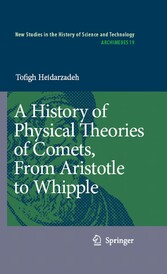Suchen und Finden
Service
A History of Physical Theories of Comets, From Aristotle to Whipple
Tofigh Heidarzadeh
Verlag Springer-Verlag, 2008
ISBN 9781402083235 , 278 Seiten
Format PDF, OL
Kopierschutz Wasserzeichen
Geräte
Although the development of ideas about the motion and trajectory of comets has been investigated piecemeal, we lack a comprehensive and detailed survey of ph- ical theories of comets. The available works either illustrate relatively short periods in the history of physical cometology or portray a landscape view without adequate details. The present study is an attempt to review - with more details - the major physical theories of comets in the past two millennia, from Aristotle to Whipple. My research, however, did not begin with antiquity. The basic question from which this project originated was a simple inquiry about the cosmic identity of comets at the dawn of the astronomical revolution: how did natural philosophers and astronomers define the nature and place of a new category of celestial objects - comets - after Brahe's estimation of cometary distances? It was from this turning point in the history of cometary theories that I expanded my studies in both the pre-modern and modern eras. A study starting merely from Brahe and ending with Newton, without covering classical and medieval thought about comets, would be incomplete and leave the fascinating achievements of post-Newtonian cometology unexplored.
Service
Shop


















